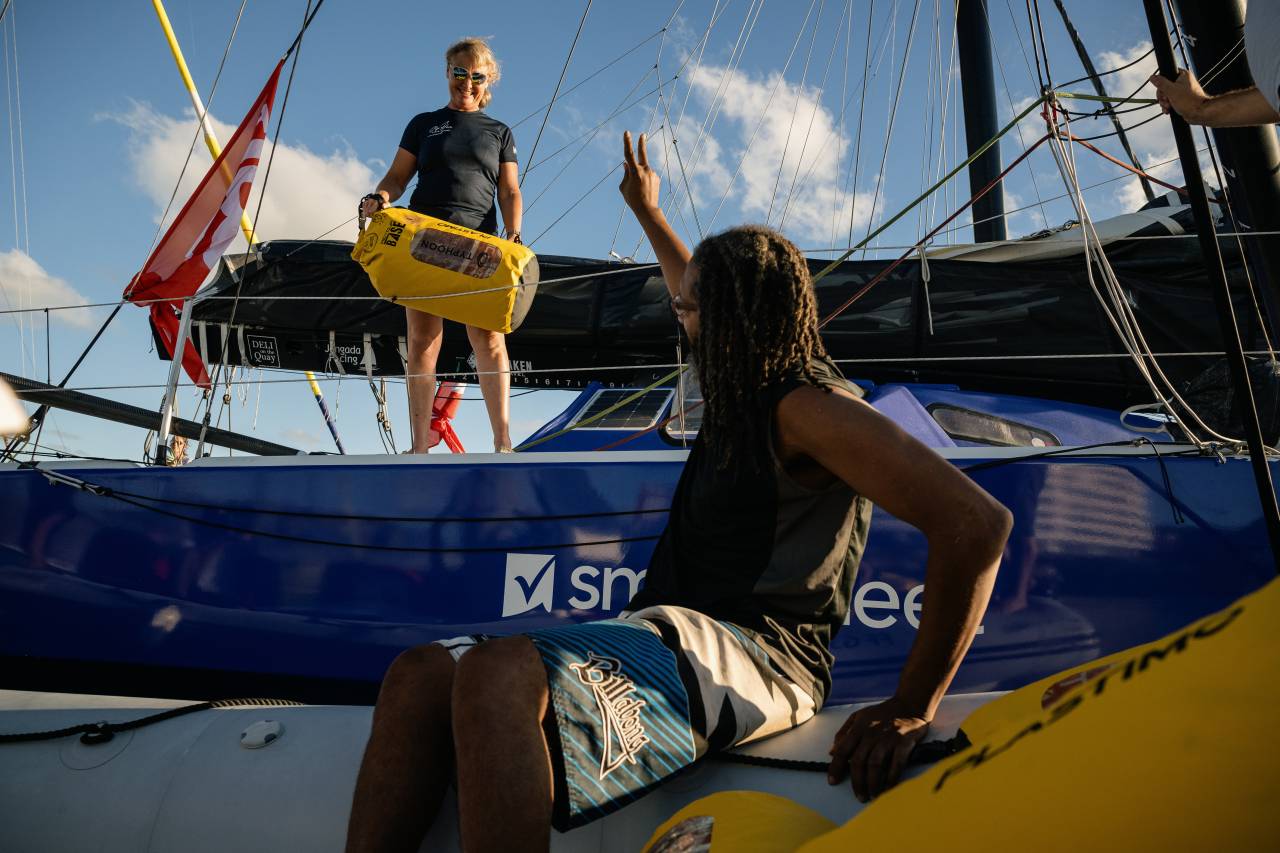From the waves of the North Atlantic to the previously forgotten cocoa plantations of Martinique, a break for the skippers

For one day the skippers who will race the Retour à La Base on Thursday left their boats and the pontoons to venture into the Martinique countryside in search of the origin of precious cocoa beans that they carry bring back to Lorient.
As IMOCA sailors they are well used to being shaken around on their boats. But hanging on in the back of a pick-up seated between pruning shears and jute bags a posse of Retour à La Base sailors hang on for dear life as the vehicle bumps along the dirt road bordered each side by sugar cane and majestic breadfruit trees. And they are approaching the family cocoa plantation of Rose Mano-Mogade that stretches majestically over a very steep hill, in the lush countryside of the North of Martinique…
As they arrive they are greeted by the scent of lemongrass. And the team from the IMOCA Monnoyeur-Duo For a Job are immediately popular for having brought bug repellent to protect the acres of fresh, tasty flesh.
After a few minutes of climbing, the first pods appear on the branches, in shades ranging from lime green to yellow-orange depending on their maturity. There are almost three years between planting a cocoa tree and its first harvest!
“It looks like mango more than chocolate!”
With a sharp, precise slice Kora Bernabé, president of Valcaco, the association of Martinican cocoa producers, splits one of the precious fruits on a protruding rock, to show the sailors the beans well protected in a whitish pulp. Blond haired Reuben, Sam Davies son is the first to taste it, “It looks like mango more than chocolate!”, he notes, visibly a little disappointed.
The Martinican producer details the stages before being able to taste a tablet. She took over her grandfather's land which had been left fallow for a long time. Harvesting, fermentation in three stages, drying, roasting… good things take time, especially when you have to start from scratch and “relearn everything about these ancestral skills and knowledge’
Forgotten heritage
Finding cocoa on magnificent Madinina shouldn't be that surprising, however. Established by Native American traders in 1660, the plant quickly became a prolific crop on the island, with no less than seven varieties exploited out of the ten that exist in the world, Nearly 6,000 tonnes of beans were being harvested by the end of the 17th century. Century in response to the greedy requests from the court of Louis XIV!
But after decades of boom, production experienced a spectacular downfall in the 1970s, notably in favour of bananas which were grown intensively for export. Meantime the cocoa tree a proud rustic plant which hardly suffers parasites was falling into oblivion...
But then at the dawn of the 2010s, a realisation of the wasted heritage inhabits a new generation of Martinique farmers, some haunted by the memory of the taste of "gwo kako", these chocolate sticks from their childhood.
"Cocoa is a pride of Martinique's heritage, which has not been tainted by slavery or health scandals like chlordecone", recalls Kora Bernabé, who in 2015 launched the Valcaco association to relaunch production with a small core of around ten enthusiasts with the ethos it be " sustainable and responsible", and sought to obtain a Protected Designation of Origin (PDO) as quickly as possible.
“It gives us something in common to savour”
Today, there are around fifty farmers on the island, including Rose Mano-Mogade, a former beautician who left everything to install her first cocoa trees in 2018.
“It is a bit like wine, each plot has its qualities and specificities, with more or less floral, spicy, or woody notes,” explains the enthusiast, who took care to also plant mango, cotton and other banana trees to provide shade for the fragile pods.
Weeding, harvesting, pruning, “The work is very physical,” explains the elegant farmer, who takes great care not to use any pesticides on her plot.
The group of skippers listen compassionately.
“It gives us something in common to savour”, Comments the skipper of Fives – Lantana Environnement, Louis Duc.
400 tablets per boat
All this work is well and good, but we must not lose sight of the essential…
“When do we get the the chocolate?”, asks Alan Roura’s daughter.
“It’s for January! », replies Anne Caron in a soft voice. With her black jacket with the prestigious tricolor collar, the roaster and best worker of France 2023 is easily noticed in the cocoa plantation.
It is to her that each Rétour à La Base competitor will return the approximately 20 kilograms of Martinican cocoa beans after the transatlantic race across the North Atlantic.
With a clever secret recipe of sugars, Caron, a magician with pots and cooking, will transform them into gourmet tablets – 400 per boat. And she rejoices in the company of the sailors who are passionate about taste and “product of excellence”!
“It is a symbolic operation, but which brings together many issues for the future, whether for Martinique, for sustainable agriculture, low-carbon maritime transport, and better cooperation between territories,” summarizes Jean-Philippe Cau , president of Lorient Grand Large.
" It's urgent "
To coordinate the operation, the organizer of the return transatlantic was able to rely on the know-how of Belco, a Bordeaux company specializing in the sourcing of coffee and cocoa, and a pioneer in sailing transport.
“Our ambition, ultimately, is to market 100% French carbon-free cocoa,” explains project manager Louis Mayaud, happy to see all the skippers who become “ambassadors of another type of consumption, concerned about our environment ".
Back on the pontoons of Fort-de-France, it is time for the distribution of bags of beans on to the IMOCAs.
Under the shade of his canvas hat, Joseph Domergue, a cocoa producer in what was once a long-abandoned forest, shakes the hand of Hungarian skipper Szabolcs Weöres, handing him the precious cargo.
In a soft voice, the Martinican is quite emotional. “It’s still a great pride to see my production set sail with all these champions. I hope this will make more people want to support organic and responsible agriculture, this is urgent.”
